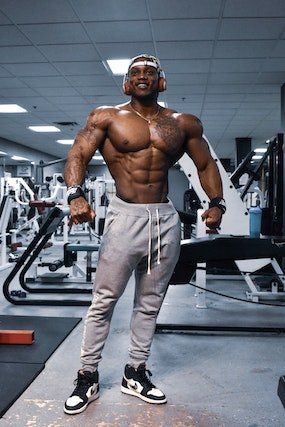
Is It Possible To Train Your Arms To Be Stronger Than Your Legs? Must Read If You Want To Go Ape
Have you ever wondered if it’s possible to train your arms to be stronger than your legs? It’s one of the many curious questions that people ask about the human body.
Maybe you’ve seen someone with incredibly strong arms, but their legs seem disproportionally weak in comparison. Or, maybe you know somebody who can leg press an absurd amount of weight but can barely curl a 20-pound dumbbell.
So, what’s the deal?
Is it possible to train your arms to be stronger than your legs?
It is possible to train your arms to be stronger than your legs. However, it is much more difficult to achieve this level of strength imbalance than it is to achieve a balance between the two muscle groups. The human body has evolved to walk upright on two legs, with the muscles in our legs being much larger and stronger than the muscles in our arms. Thus, it takes a lot more work to build up the arm muscles to the point where they are stronger than the leg muscles. Since we use our legs to walk and stand all day long, and have done so since an early age, it is more common for people to have stronger legs than arms. The best way to train your arms to be stronger than your legs is to focus on compound exercises that target the upper body. For example, performing exercises such as pull-ups and chin-ups will help to develop strength in your arms more than in your legs. However, it is important to remember that achieving a balanced physique is still the best way to stay healthy and improve your overall strength.
The tale of the tape…
The way the human body has changed over thousands of years to allow us to walk on two legs is fascinating. For example, our hips and pelvis have evolved to be much narrower than our shoulders, which has helped to give us better balance when walking.
Additionally, the muscles in our legs are much larger and stronger than the muscles in our arms. This is because they have to support our entire body weight when we walk, run, or stand.
While it is possible to train your arms to be stronger than your legs, it is much more difficult to achieve this level of strength imbalance than it is to achieve a balance between the two muscle groups.
Given that our legs have evolved to be stronger than our arms, it takes more effort to build up the muscles in our arms to comparable levels.
What muscles are involved?
The muscles in our arms are obviously different than the muscles in our legs, but they both work together to help us move.
The main muscles in our arms are the biceps and triceps. The biceps are located on the front of the arm and help to flex the elbow, while the triceps are located on the back of the arm and help to extend the elbow.
The shoulder muscles, which are also located in the arms, help to raise and lower the arms. The shoulder joint has a greater range of motion than any other joint in the body, which allows us to reach and grab things.
Its ability to rotate and move in multiple directions also helps to stabilize the arm when we are moving it, which also allows us to throw a ball or punch someone.
The muscles in our legs are much larger and more complex than the muscles in our arms.
The main muscles in our legs are the quadriceps, which are located on the front of the thigh, and the hamstrings, which are located on the back of the thigh.
The quadriceps are the largest muscle group in the human body and are responsible for extending the knee. The hamstrings, on the other hand, help to flex the knee and also work to extend the hip.
There are also several smaller muscles in the legs that help to stabilize the knee and ankle joints, as well as the muscles in the feet that help us to stand and walk, such as the calves.
The hip joint is another important part of the leg, as it allows us to move our legs in all directions, which is necessary for walking, running, and climbing.

Range of motion
The range of motion is the measurement of how far a joint can move in a particular direction.
The shoulder has the greatest range of motion of any joint in the human body, as it can move in multiple directions. We use our arms for many things, such as picking up objects and throwing a ball.
The elbow joint has a much smaller range of motion, as it can only move in one direction. This allows us to extend and flex our arms, but not to move them in a circular motion.
The hip joint also has a large range of motion, as it can move in all directions. This is necessary for walking and running.
Both the shoulder and hip joints have a ball and socket joint, which allows them to move in a greater range of motion than other types of joints.
The knee joint has a smaller range of motion than the hip joint, as it can only move in one direction. This allows us to extend and flex our legs, but not to move them in a circular motion.
The ankle joint has a very small range of motion, as it can only move up and down. This helps to stabilise the foot when we are walking or running.
Related: How Much Stronger Are A Persons Legs Than Their arms? The Ultimate Limb Face Off
Strength
The amount of force that a muscle can produce is called its strength.
The quadriceps, which are the muscles on the front of the thigh, are the strongest muscle in the human body. They enable us to walk, run, and jump by extending the knee joint.
The hamstrings are the large muscles on the back of your thigh. They help to lift your leg up (flexing the knee) and also work when you stand up from a seated position (extending the hip).
The calf muscles, located on the back of each lower leg, are essential for walking and running. They stabilize the ankle joint and help raise the heel off the ground.
The biceps, which are located on the front of the upper arm, are responsible for flexing the elbow joint and are used when we lift something.
The triceps, which are located on the back of the upper arm, are responsible for extending the elbow joint and are used when we push something.
The forearm muscles, located on the front and back of the lower arm, help to stabilize the wrist and enable us to grip something.
Generally speaking, the muscles in our legs are much stronger than the muscles in our arms. This is because the legs support the body’s weight and are used for walking, running, and jumping.
It is possible to train the muscles in our arms to be stronger than the muscles in our legs, but it is very difficult to do so.
This is because the muscles in our legs are much larger and more complex than the muscles in our arms.
Evolution
The human body is designed in such a way that the muscles in our legs are much stronger than the muscles in our arms.
This is because our ancestors needed to be able to walk long distances and run away from predators.
Over time, the muscles in our legs have become much stronger and more efficient at walking and running. However, the muscles in our arms have not changed much since our ancestors first began to use them for tasks such as climbing and throwing.
So, while it is possible to train the muscles in our arms to be stronger than the muscles in our legs, it is not something that has happened naturally over the course of evolution.

Attributes
There are several attributes that contribute to the strength of a muscle, such as its size, shape, and number of fibers.
The size of a muscle is determined by the number of cells that make up the muscle. The more cells there are, the larger the muscle will be.
The shape of a muscle can also affect its strength. Muscles that are long and thin will generate less force than muscles that are short and thick.
The number of fibers in a muscle is also a determining factor in its strength. The more fibers there are, the stronger the muscle will be.
Finally, the way in which the muscle is used can also affect its strength. Muscles that are used frequently will become stronger than muscles that are used less often.
So, while it is possible to train the muscles in our arms to be stronger than the muscles in our legs, it is not something that will happen automatically.
The muscles in our arms will only become stronger if we use them frequently and put them under a lot of stress.
Related: Do You Squeeze Your Muscles Whenever You Exercise? 12 Crucial Factors To Maximise Gains
Here’s what the science says
Yes, it is possible to train your arms to be stronger than your legs, but it’s difficult to do so. The muscles in our legs are much larger and more complex than the muscles in our arms, which gives them a natural advantage.
However, if you use your arms frequently and put them under a lot of stress, they will become stronger over time.
Keep in mind, however, that the muscles in your legs will always be stronger than the muscles in your arms. As mentioned previously, our ancestors had to be able to walk long distances and run away from predators, so our bodies have evolved to be able to do this.
Over time, the muscles in our legs have become much stronger and more efficient at walking and running. So, while you can train your arms to be stronger than your legs, it’s not something that will happen naturally.
Final thoughts…
As you can see, there are many different muscles in the arms and legs that contribute to their overall strength.
While it is true that the muscles in our legs are naturally stronger than the muscles in our arms, it is possible to train your arms to be stronger than your legs.
This can be done by performing exercises that target the muscles in the arms, such as weightlifting and push-ups, but you will need to be consistent and extremely dedicated with your training over a long period of time in order to see results you desire.
It is also important to eat a healthy diet and get enough rest, as this will help to ensure that your muscles are able to recover from the stress of exercise.
With dedication and hard work, it is possible to train your arms to be stronger than your legs. However, very few people are able to achieve this level of strength, and it is not necessary for most activities in daily life.
You have to ask yourself why you want to achieve this goal, and if the benefits are worth the time and effort required.
Are you wanting to get your arms stronger than your legs and if so why? Let us know in the comments below.


